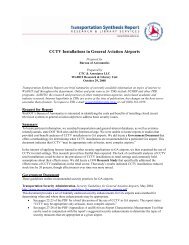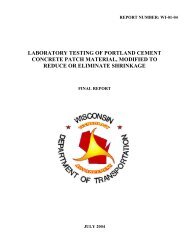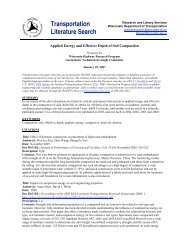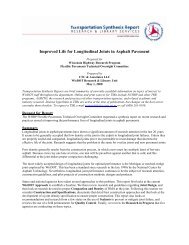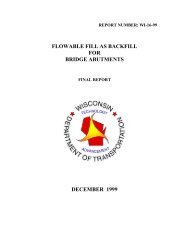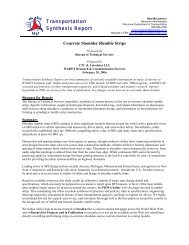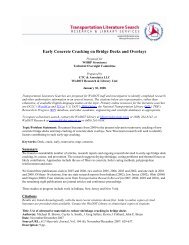Limitations of the Use of Abrasives in Winter ... - Clear Roads
Limitations of the Use of Abrasives in Winter ... - Clear Roads
Limitations of the Use of Abrasives in Winter ... - Clear Roads
Create successful ePaper yourself
Turn your PDF publications into a flip-book with our unique Google optimized e-Paper software.
High-Speed Urban <strong>Roads</strong>. No benefit is expected when apply<strong>in</strong>g dry abrasives to <strong>the</strong>se roads where posted speed<br />
limits exceed 30 mph. Application <strong>of</strong> prewetted abrasives may be appropriate for this road type; hot abrasives may<br />
also be considered.<br />
Low-Speed Urban <strong>Roads</strong>. Limit dry abrasive application to <strong>the</strong> parts <strong>of</strong> <strong>the</strong> road where brak<strong>in</strong>g, accelerat<strong>in</strong>g or<br />
maneuver<strong>in</strong>g is done, and only use this approach when <strong>the</strong> snowpack is expected to persist. Application <strong>of</strong> prewetted<br />
abrasives will allow <strong>the</strong> material to rema<strong>in</strong> on <strong>the</strong> road surface longer. Aga<strong>in</strong>, hot application methods may be<br />
appropriate.<br />
Urban Intersections. Dry abrasives can be used where <strong>the</strong> <strong>in</strong>tersection is likely to be snow- or ice-covered for a<br />
longer-than-normal period <strong>of</strong> time. Prewetted abrasives will rema<strong>in</strong> <strong>in</strong> place longer; hot application methods might<br />
also be considered.<br />
References<br />
EPA. 2005. “What You Should Know About Safe W<strong>in</strong>ter <strong>Roads</strong> and <strong>the</strong> Environment,” EPA 901-F-05-020.<br />
http://www.epa.gov/region1/topics/water/pdfs/w<strong>in</strong>terfacts.pdf<br />
FHWA. 1996a. “Anti-ic<strong>in</strong>g Strategies Improve Safety and Protect <strong>the</strong> Environment,” Focus, May 1996.<br />
http://www.tfhrc.gov/focus/archives/56nevada.htm<br />
FHWA. 1996b. Manual <strong>of</strong> Practice for an Effective Anti-ic<strong>in</strong>g Program: A Guide for Highway W<strong>in</strong>ter Ma<strong>in</strong>tenance<br />
Personnel.<br />
http://www.fhwa.dot.gov/reports/mopeap/mop0296a.htm<br />
FHWA. 1996c. “Sav<strong>in</strong>g Money and <strong>the</strong> Environment,” Publication No. FHWA-SA-96-045 (CS092).<br />
http://ops.fhwa.dot.gov/wea<strong>the</strong>r/resources/publications/tech_briefs/cs092.htm<br />
FHWA. 1998. Test and Evaluation Project No. 28: Anti-ic<strong>in</strong>g Technology, Field Evaluation Report, Publication No.<br />
FHWA-RD-97-132.<br />
http://ntl.bts.gov/lib/5000/5700/5786/132.pdf<br />
Gertler, A., et al. 2006. “A Case Study <strong>of</strong> <strong>the</strong> Impact <strong>of</strong> W<strong>in</strong>ter Road Sand/Salt and Street Sweep<strong>in</strong>g on Road Dust<br />
Re-entra<strong>in</strong>ment,” Atmospheric Environment 40, 5976-5985.<br />
Keyser, J.H. 1973. “De-ic<strong>in</strong>g Chemicals and <strong>Abrasives</strong>: State <strong>of</strong> <strong>the</strong> Art,” Highway Research Record 425, 36-51.<br />
http://www.clearpathicemelt.net/docs/DE-<br />
ICING%20CHEMICALS%20AND%20ABRASIVES%20STATE%20OF%20THE%20ART.doc<br />
Kuemmel, D.A., and Q. Bari. 1996. “Benefit-Cost Comparison <strong>of</strong> Salt-Only Versus Salt-Abrasive Mixtures <strong>Use</strong>d<br />
<strong>in</strong> W<strong>in</strong>ter Highway Ma<strong>in</strong>tenance <strong>in</strong> <strong>the</strong> United States.” In Snow Removal and Ice Control Technology, Selected<br />
Papers Presented at <strong>the</strong> Fourth International Symposium, Reno, Nevada, August 11-16, 1996.<br />
http://www.salt<strong>in</strong>stitute.org/marquette2-full.pdf<br />
NCHRP. 2004. Report 526: Snow and Ice Control: Guidel<strong>in</strong>es for Materials and Methods.<br />
http://onl<strong>in</strong>epubs.trb.org/Onl<strong>in</strong>epubs/nchrp/nchrp_rpt_526.pdf<br />
Nixon, W.A. 2001a. The <strong>Use</strong> <strong>of</strong> <strong>Abrasives</strong> <strong>in</strong> W<strong>in</strong>ter Ma<strong>in</strong>tenance: F<strong>in</strong>al Report <strong>of</strong> Project TR 434, Iowa DOT.<br />
http://www.iihr.uiowa.edu/products/pubvid/pdf/IIHR416.pdf<br />
Nixon, W.A. 2001b. “<strong>Use</strong> <strong>of</strong> <strong>Abrasives</strong> <strong>in</strong> W<strong>in</strong>ter Ma<strong>in</strong>tenance at <strong>the</strong> County Level,” Transportation Research<br />
Record 1741.<br />
See abstract at http://pubs<strong>in</strong>dex.trb.org/document/view/default.asp?lbid=688956.<br />
Salt Institute. 1995. “Deic<strong>in</strong>g Salt Facts: A Quick Reference.”<br />
http://www.salt<strong>in</strong>stitute.org/snowfight<strong>in</strong>g/deic<strong>in</strong>gsaltfacts.zip<br />
Salt Institute. 2004. Highway Salt and Our Environment.<br />
http://www.salt<strong>in</strong>stitute.org/publications/saltandenvironment-english.pdf<br />
4



